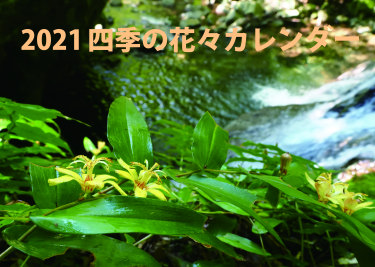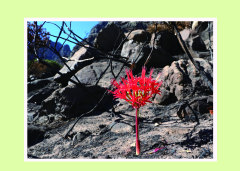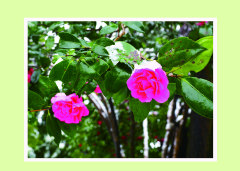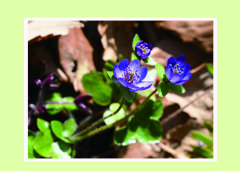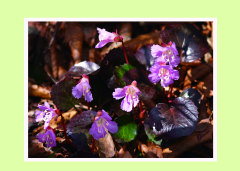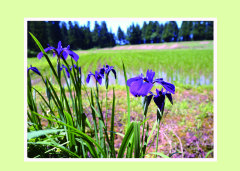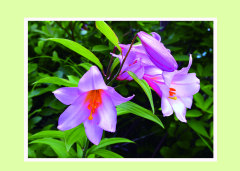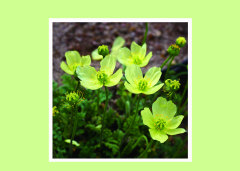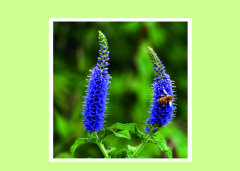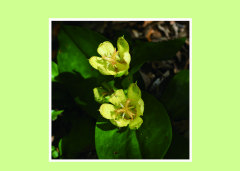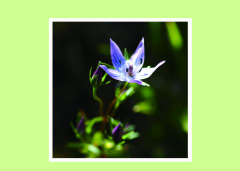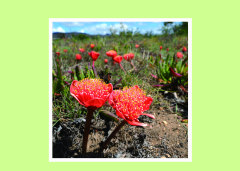| January |
|
Brunsvigia marginata, Amaryllidaceae
(Pearl, Western Cape, South Africa)
After the wildfire burns down the shrub, it sprouts from the ground. It monopolizes the nutrients of ash and sunlight, then produces crimson flowers. The petals glitter with gold powder on the surface. It's like a phoenix that jumps into the fire to regenerate.
 Click here to view Click here to view
|
| February |
|
Camellia japonica ("Tsubaki"), Theaceae
(Kinuta Park, Setagaya-ku, Tokyo)
Endemic to Japan as well as the closely related Sasanqua (Sasanqua). It
grows naturally near the coasts of various parts of Japan except Hokkaido.
Izu Oshima island and Hagi City in Yamaguchi Pref. are famous. Oil is extracted
from the seeds and used in cosmetics. The logo of famous Japanese cosmetic
maker, Shiseido is designed from camellia.
 Click here to view Click here to view |
| March |
|
Hepatica nobilis var. japonica (Japanese liverleaf "Owmisumi sou"), Ranunculaceae
(Yukiguni Botanical Garden, Nagaoka City, Niigata Prefecture)
It grows naturally on the Sea of Japan side. There are many communities in Niigata, and it is designated as a prefectural flower. The Japanese name comes from the pointed leaves in a triangle. There are various colors such as pink, blue, and white, and there are also double blooms, but most of them are illegally collected and only white ones are remained. It has another name - Snow breaker.
 Click here to view Click here to view
|
| April |
|
Shortia uniflora (Nippon bells, "Iwa uchiwa"), Diapensiaceae
(Mt. Mikuniyama, Takashima City, Shiga Prefecture)
Endemic to Japan and is distributed in the subalpine zone of northern Japan.
It blooms as the snow melts, and the leaves are evergreen, shiny and thick.
The Japanese name (Iwa uchiwa) comes from the leaves resembling paper fan.
 Click here to view Click here to view
|
| May |
|
Iris ensata (Japanese iris "Nohanshobu"), Iridaceae
(At the foot of Mt. Nioji, Shibata City, Niigata Prefecture)
Popular in wetlands throughout Japan. This species is the original species
of Hanashobu, a horticultural species. This means that it was named after
the horticultural species were created. There is a yellow streak at the
base of the petals, which distinguishes it from Hanashobu.
 Click here to view Click here to view
|
| June |
|
Lilium rubellum ("Hime-sayuri"), Liliaceae
(Mt. Mikagura, Aga Town, Niigata Prefecture)
Growing in deep mountains near the prefectural borders of Niigata, Fukujima,
and Yamagata. Endemic to Japan. This name was given because it is smaller
than Sasayuri (see back cover) distributed in western Japan. Also known
as Otomeyuri (Otome Yuri). In recent years, it has been cultivated for
tourism.
 Click here to view Click here to view
|
| July |
|
Meconopsis prattii (Himalayan blue poppy), Papaveraceae
(Chuan Hua Tang, Western Sichuan, China)
Ancient Western China was in the shallow sea with many limestone piles of shellfish and coral carcasses. Lime dissolved in water solidifies to form a dike, created ponds. Blue poppies are often seen by the pond. It stood like a water spirit (nymph).
 Click here to view Click here to view
|
| August |
|
Papaver fauriei ("Rishiri hinageshi"), Papaveraceae
(Mt. Rishiri, Hokkaido)
The only one native poppy in Japan and endemic. It blooms in a volcanic
soil of collapse area near the top of Mt. Rishiri - northern most mountain
in Japan. In recent years, due to erroneous conservation activities, crossing
with closely related species have progressed, and there is concern about
extinction.
Click here to view
|
| September |
|
Pseudolysimachion subsessile ("Ruri Torano-o"), Plantaginaceae
(Mt. Ibuki, Maibara City, Shiga Prefecture)
Grows naturally in the flower field on the summit of Mt. Ibuki. Endemic
to Japan. "Ruri" means color of lapis lazuli which was introduced
to Japan through the Silk Road from Afghanistan. It . Many of the flowers
named "Torano-o", such as Lysimachia clethroid, belong to the
Primrose family.
 Click here to view Click here to view
|
| October |
|
Tricyrtis ohsumiensis ("Takakuma Hototogisu"), Liliaceae
(Mt. Takakuma, Tarumizu City, Kagoshima Prefecture)
Subspecies of Tricyrtis flava, an endemic species of Miyazaki Prefecture,
and blooms in the rocky area on the northwestern ridge of Mt. Takakuma
on the Osumi Peninsula, Kagoshima Prefecture. It is lighter in color and
wider in leaves than Tricyrtis flava.
 Click here to view Click here to view
|
| November |
|
Swertia pseudochinensis ("Murasaki senburi"), Gentianaceae
(Mt. Ubusan, Shinshiro City, Aichi Prefecture)
Like gentian, the root is a gastrointestinal drug. The Japanese name comes
from the fact that the bitterness does not disappear even when it is put
in boiling water and shaken a thousand times.
It grows well on serpentine soil, where other plants are difficult to grow.
 Click here to view Click here to view
|
| December |
|
Haemanthus coccineus (Blood lily),Amaryllidaceae
(Bredasdorf, Western Cape, South Africa)
It has a flower head like a big red onion shaved, and has a black streak
like a snake scale on the floral pattern. It grows in clusters on dry sand
near the coast.
April Fool Lily (Haemanthus albiflos "Mayuhakeomoto") that gives
white flower head is a kin of this species.
 Click here to view Click here to view
|
| Back cover |
|
Lilium japonicum (Bamboo Lily "Sasa yuri"), Liliaceae
(Mt, Yokokura, Ochi Town, Kochi Prefecture)
A lily unique to Japan, it grows naturally in the bright mountains of western
Japan. The flower is similar to Lilium rubellum, but the color is light
and it looks neat. The leaves are as thin as bamboo grass. Mt. Yokogura
is a place where Dr. Tomitaro Makino, a famous botanist in Japan, spent
his youth collecting plants, and the named many new species. |
| Full year |
Click here for batch display of PDF files for one year Click here to view Click here to view |
